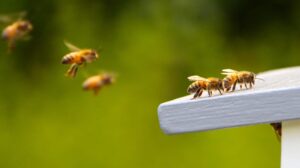April 06, 2022 | Black & Kletz Allergy

It should be noted that there is another type of stinging insect that individuals should be aware of, although it does not fly, nor is it common in the Washington, DC metro area. Fire ants will bite and sting. They inject their venom while stinging which can lead to anaphylactic reactions (i.e., anaphylaxis) in some allergic individuals. Although anaphylaxis can occur, the more typical reaction to a fire ant is that of a local burning pain with an accompanying red bump that can turn into a white fluid-filled pustule within a day or two. As mentioned above, they are not common in the Washington, DC metropolitan area however, the first documented infestation of fire ants in the state of Virginia was in 1989. Fire ants have also been found in Maryland.
When stung by a flying insect, most people have either no reaction at all or they have a small local reaction at the site of the sting. Individuals with this type of response are at no increased risk for an anaphylactic reaction than that of the general population. Some individuals will develop a large swollen red area where they were stung. This large local reaction can reach the size of a baseball in some instances. Even though there is a large local reaction, there is no increased risk of an anaphylactic reaction from the insect sting. On the other hand, approximately 3% of individuals will develop a systemic reaction to an insect sting which may include hives (i.e., urticaria), generalized itching (i.e., pruritus), swelling (i.e., angioedema), chest tightness, shortness of breath, wheezing, abdominal cramping, and/or drop in blood pressure.
The diagnosis of an insect sting allergy is done by board certified allergists like the ones at Black & Kletz Allergy. The allergist will perform a comprehensive history and physical examination. Depending on the history taken from the patient, allergy testing to flying insects is usually the next step. Allergy testing is usually done by the preferred method of skin testing, although blood testing is occasionally performed depending on the situation.
If an individual has a positive allergy test to any of the stinging insect venoms, it is highly recommended that this individual go on a course of venom allergy immunotherapy (i.e., allergy desensitization, allergy shots, allergy injections) as it is tremendously efficacious in preventing further anaphylactic reactions from flying insect stings. Venom allergy immunotherapy involves receiving progressively larger doses and volumes of insect venom to the patient weekly over a period of 10 weeks, then every 2 weeks for 1 dose, then every 3 weeks for 1 dose, then a maintenance dose every 4 weeks for 1 year, and then the maintenance dose can be reduced to every 6 weeks for several more years. This maintenance dose is essentially comparable to the amount of venom in an actual flying insect sting.
All patients with flying insect sting allergies are prescribed a self-injectable epinephrine device such as EpiPen, Auvi-Q, or Adrenaclick. If one uses a self-injectable epinephrine device, they should go immediately to the closest emergency room. It is also important to note that unlike other flying stinging insects, honey bees leave their stinger in the skin of their victims. If one sees a stinger at the site of a sting, one should not pull out the stinger. It should be scraped off with a finger nail, credit card, or other flat surface. Pulling out a stinger can cause more venom to be introduced into the person’s body which can obviously be more detrimental.
The board certified allergy doctors at Black & Kletz Allergy will promptly answer any questions you may have regarding insect stings or any related conditions. Our allergy doctors have been diagnosing and treating insect sting allergies in the Washington, DC, Northern Virginia, and Maryland metropolitan area for more than 50 years. We have 3 convenient locations in the DC metro area with offices in Washington, DC, McLean, VA (Tysons Corner, VA), and Manassas, VA. There is on-site parking at each location and both the Washington, DC and McLean, VA offices are Metro accessible. There is a free shuttle that runs between our McLean, VA office and the Spring Hill metro station on the silver line. To schedule an appointment, please call us at any one of our 3 locations. Alternatively, you can click Request an Appointment and we will respond within 24 hours by the next business day. Black & Kletz Allergy is dedicated in providing the most up-to-date diagnostic and treatment modalities in the field of allergy, asthma, and immunology.












